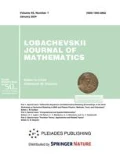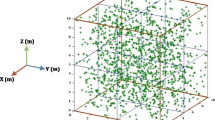Abstract
Mathematical model of groundwater flow in fractured porous media implemented in the GeRa code is presented. It uses the discrete fracture matrix approach which allows for explicit fractures approximation and couples 2D and 3D flow models in fractures and porous matrix respectively. Discretization is done using finite volume method on general conformal polyhedral grids, while 2D surface grids on fractures being the trace of 3D grid in the porous media on the fractures’ surfaces. The model is applied to assess the effect of fracture zones on groundwater flow through a projected radioactive waste deep geological disposal.




Similar content being viewed by others
REFERENCES
J. Bear, C. F. Tsang, and G. de Marsily, Flow and Contaminant Transport in Fractured Rock (Academic, San Diego, CA, 1993).
F. V. Grigorev, A. V. Plenkin, and I. V. Kapyrin, ‘‘To the necessity of taking into account the disposal’s structure whilst far field waste input modeling,’’ Radioactive Waste, No. 8, 82–86 (2018).
M. Karimi-Fard, L. J. Durlofsky, and Khalid Aziz, ‘‘An efficient discrete-fracture model applicable for general-purpose reservoir simulators,’’ SPE J. 9, 227–236 (2004).
T. H. Sandve, I. Berre, and J. M. Nordbotten, ‘‘An efficient multi-point flux approximation method for Discrete Fracture Matrix simulations,’’ J. Comput. Phys. 231, 3784–3800 (2012).
A. V. Plenkin, A. Yu. Chernyshenko, V. N. Chugunov, and I. V. Kapyrin, ‘‘Adaptive unstructured mesh generation methods for hydrogeological problems,’’ Vychisl. Metody Program. 16, 518–553 (2015).
K. V. Martynov and E. V. Zakharova, ‘‘The analysis of localization and the scenario of evolution of DGDF for RW at the Yeniseisky site (Krasnoyarsk region),’’ Radioactive Waste 2 (3), 52–62 (2018) [in Russian].
D. Bagaev, F. Grigorev, I. Kapyrin, I. Konshin, V. Kramarenko, and A. Plenkin, ‘‘Improving parallel efficiency of a complex hydrogeological problem simulation in GeRa,’’ in Supercomputing. RuSCDays 2019, Ed. by V. Voevodin and S. Sobolev, Vol. 1129 of Communications in Computer and Information Science (Springer, Cham, 2019), pp. 265–277.
Author information
Authors and Affiliations
Corresponding authors
Additional information
(Submitted by A. V. Lapin)
Rights and permissions
About this article
Cite this article
Grigorev, F.V., Kapyrin, I.V. & Plenkin, A.V. Discrete Fracture Matrix Model Applied to the Computation of Water Flow Through the Underground Facility. Lobachevskii J Math 41, 526–532 (2020). https://doi.org/10.1134/S1995080220040101
Received:
Revised:
Accepted:
Published:
Issue Date:
DOI: https://doi.org/10.1134/S1995080220040101




